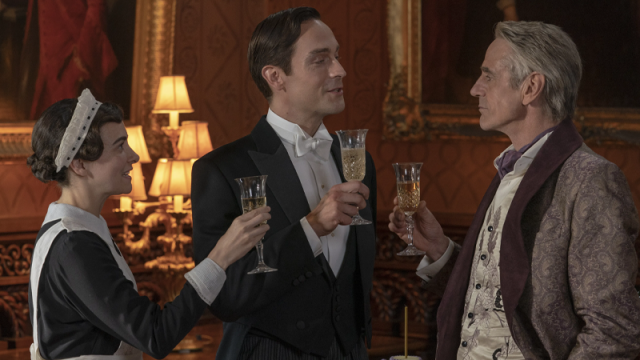We’re only two episodes in, but there’s already a lot going on in Watchmen in the moments between Regina King kicking arse to sick music. But perhaps one of the most fascinating things is whatever the hell Jeremy Irons is getting up to in that manor of his—and one of his accomplices in that weirdness, Tom Mison, is drawing some interesting parallels to the comics when talking about it.
Mison (better known as Ichabod from Sleepy Hollow) plays Mr. Phillips in Watchmen, one of two servants to Irons’ character—who has long been assumed to be Adrian Veidt, a.k.a. ex-hero/alien squid unleasher Ozymandias from the original comics by Alan Moore and Dave Gibbons. HBO, however, have adamantly refused to explicitly acknowledge Irons’ character as Veidt just yet, referring to the character simply as “Lord of the Manor” in credits and associated press material.
Just who Irons is really meant to be playing is one of the biggest mysteries of the series so far, one compounded in this week’s episode when we see him revel in the performance of a play he wrote, The Watchmaker’s Son.
It’s basically a community theatre retelling of the origin of how Jon Osterman became Dr. Manhattan, performed by Mr. Phillips and Ms. Crookshanks (Sara Vickers). With Mison’s Phillips in the role of Osterman, he steps into the chamber that broke Osterman’s body and rebuilt him, atom by atom, as the omnipotent hero…recreated by Irons’ character roasting Phillips alive.
So Phillips dies. Well, sort of. Because it turns out that the mysterious Lord of the Manor has a whole cavalcade of identical Phillpses and Crookshanks in his service, making his fascination with the origins of Doctor Manhattan and his capacity for great violence all the more intriguing.
Discussing the shocking moment with the Hollywood Reporter, however, Mison himself added a whole other layer to the mystery. The actor drew parallels to the so-far sectioned off plotline at the manor in Watchmen as the series’ own take on the original comics’ Tales of the Black Freighter—an in-universe swashbuckling homage to the pulp comics of the golden age that wove in and around the story of the main series, drawing parallels between the grim adventures of a young mariner and the characters in Watchmen’s wider world, particularly Ozymandias.
“My whole experience started with a two-hour conversation with Damon [Lindelof] about comics generally, the Watchmen comics in particular, and the show as a whole,” Mison said. “It seemed as though the tone of [my scenes] was quite similar to Tales of the Black Freighter…that for a small section of each episode, you’ll flick away to a completely separate story, and hopefully it will throw everyone off guard in quite a fun way. And then gradually over the nine episodes, you’ll see how our world is connected to the world of the rest of the show.”
“I was aware of that from the very beginning, and found that quite exciting. In fact, the first script that I read, he had put in a little red herring to avoid leaks and spoilers, and the name of the play that Jeremy’s character writes wasn’t The Watchmaker’s Son. It was, in fact, The Black Freighter,” Mison added—but not before immediately raising and then debunking his own theory that Irons is actually playing some form of Max Shea, the writer who wrote Tales of the Black Freighter in Watchmen’s universe.
But even with that theory cast aside, Mison makes an interesting comparison, given that Watchmen already has a perhaps more oblique parallel for The Black Freighter’s story-within-a-story hook: American Hero Story, a delectably trashy pastiche of American Horror Story but for Watchmen’s alt-history of costumed vigilantes.
But it further throws into question just how connected—and just how really rooted in the reality we see of Watchmen’s Tulsa-based storyline—this aspect of the series could be. Is it simply isolated because Irons’ character is? Is it isolated because it’s not as real as we think it is, letting the surreality of this strange man fascinated by Doctor Manhattan and his legion of identical servants run around be explained away as a fictitious internal narrative?
There have already been a few weird hints of a sort of collective awareness of the Lord of the Manor—his manor itself has been seen in other moments of the series, like in glimpses of news footage of Doctor Manhattan seemingly building and destroying a facsimile of it on Mars, and Angela Abar’s son Topher building a floating, metallic version of it in his room in the last episode. But that doesn’t stop us asking just how real any of it actually is, or, if like Tales was to Watchmen, it’s simply an internal tale meant to reflect upon the reality of our actual protagonists.
Whatever it ends up being, and whoever Mison’s Mr. Phillips ends up actually ends up serving, the one thing we do know right now is that it’s a big part of what’s keeping us hooked into this show so far.
